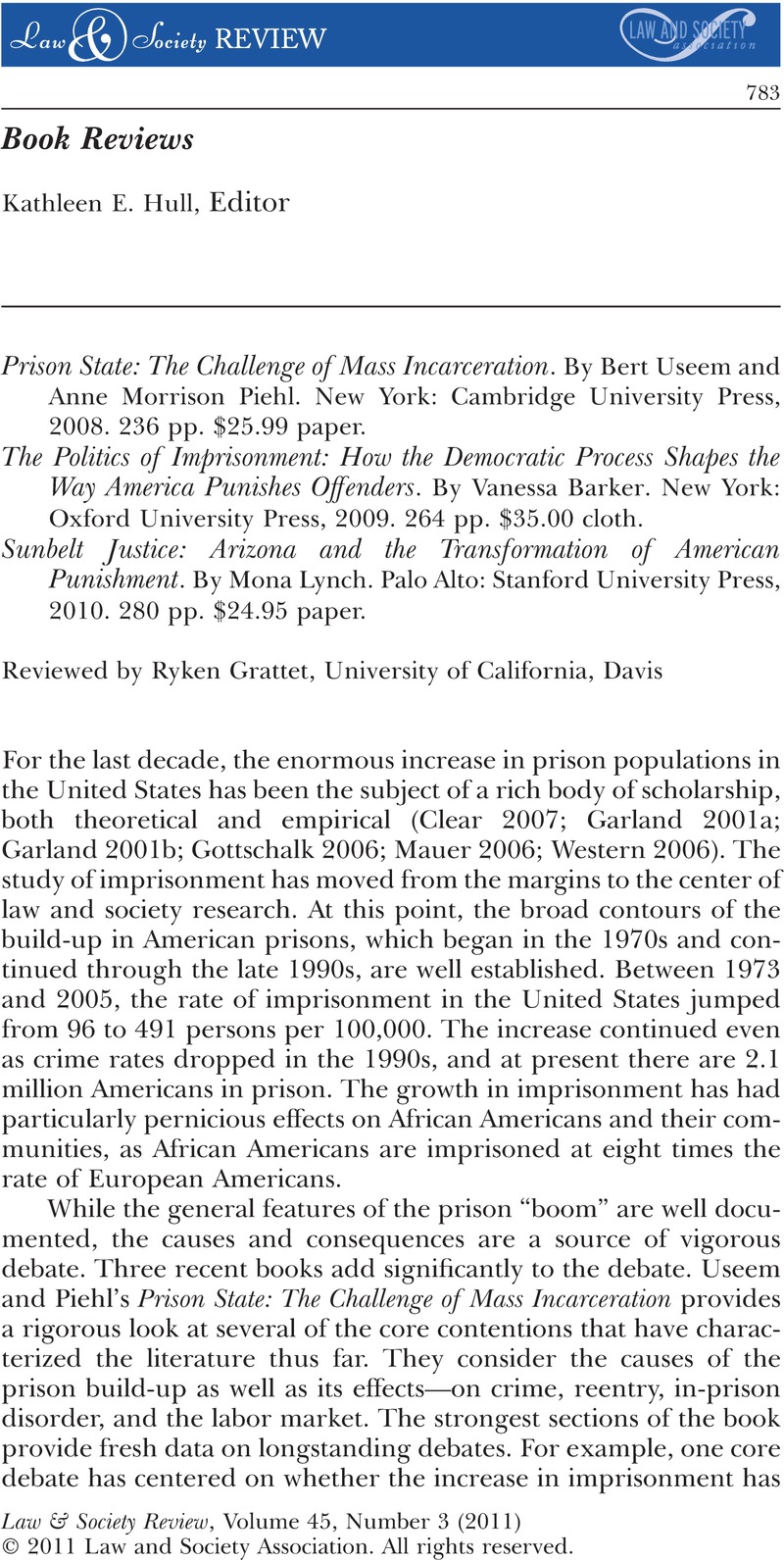No CrossRef data available.
Article contents
Prison State: The Challenge of Mass Incarceration. By Bert Useem and Anne Morrison Piehl. New York: Cambridge University Press, 2008. 236 pp. $25.99 paper. - The Politics of Imprisonment: How the Democratic Process Shapes the Way America Punishes Offenders. By Vanessa Barker. New York: Oxford University Press, 2009. 264 pp. $35.00 cloth. - Sunbelt Justice: Arizona and the Transformation of American Punishment. By Mona Lynch. Palo Alto: Stanford University Press, 2010. 280 pp. $24.95 paper.
Review products
Prison State: The Challenge of Mass Incarceration. By Bert Useem and Anne Morrison Piehl. New York: Cambridge University Press, 2008. 236 pp. $25.99 paper.
The Politics of Imprisonment: How the Democratic Process Shapes the Way America Punishes Offenders. By Vanessa Barker. New York: Oxford University Press, 2009. 264 pp. $35.00 cloth.
Sunbelt Justice: Arizona and the Transformation of American Punishment. By Mona Lynch. Palo Alto: Stanford University Press, 2010. 280 pp. $24.95 paper.
Published online by Cambridge University Press: 01 January 2024
Abstract
An abstract is not available for this content so a preview has been provided. Please use the Get access link above for information on how to access this content.

- Type
- Book Reviews–Kathleen E. Hull, Editor
- Information
- Copyright
- © 2011 Law and Society Association.
References
Calavita, K. (1992) Inside the State: The Bracero Program, Immigration, and the I.N.S. New York: Routledge.Google Scholar
Clear, T.R. (2007) Imprisoning Communities: How Mass Incarceration Makes Disadvantaged Neighborhoods Worse. New York: Oxford Univ. Press.CrossRefGoogle Scholar
Feeley, M., & Simon, J. (1992) “The New Penology: Notes on the Emerging Strategy of Corrections and Its Implications,” 30 Criminology 449–74.CrossRefGoogle Scholar
Garland, D. (2001a) The Culture of Control: Crime and Social Order in Contemporary Society. Chicago, IL: Univ. of Chicago Press.CrossRefGoogle Scholar
Garland, D., ed. (2001b) Mass Imprisonment: Social Causes and Consequences. Thousand Oaks, CA: Sage.CrossRefGoogle Scholar
Goldstone, J.A., & Useem, B. (1999) “Prison Riots as Microrevolutions: An Extension of State-Centered Theories of Revolution,” 104 American J. of Sociology 985–1029.CrossRefGoogle Scholar
Gottschalk, M. (2006) The Prison and the Gallows: The Politics of Mass Incarceration in America. New York: Cambridge Univ. Press.Google Scholar
Page, J. (2011) The Toughest Beat: Politics, Punishment, and the Prison Officers Union in California. New York: Oxford Univ. Press.CrossRefGoogle Scholar
Perkinson, R. (2010) Texas Tough: The Rise of America's Prison Empire. New York: Metropolitan Books.Google Scholar
Schoenfeld, H. (2009) The Politics of Prison Growth: From Chain Gangs to Work Release Centers and Supermax Prisons, Florida, 1955–2000. Evanston, IL: Northwestern University Press.Google Scholar
Sevigny, E.L., & Caulkins, J.P. (2006) “Kingpins or Mulies: An Analysis of Drug Offenders Incarcerated in Federal and State Prisons,” 3 Criminology and Public Policy 401–34.Google Scholar
Useem, B, & Goldstone, J.A. (2002) “Forging Social Order and Its Breakdown: Riot and Reform in US Prisons,” 67 American Sociological Rev. 499–525.CrossRefGoogle Scholar
Western, B., & Beckett, K. (1999) “How Unregulated is the U.S. Labor Market? The Penal System as a Labor Market Institution,” 104 American J. of Sociology 1030–160.CrossRefGoogle Scholar
Western, B., & Pettit, B. (2005) “Black-White Wage Inequality, Employment Rates, and Incarceration,” 111 American J. of Sociology 553–78.CrossRefGoogle Scholar




